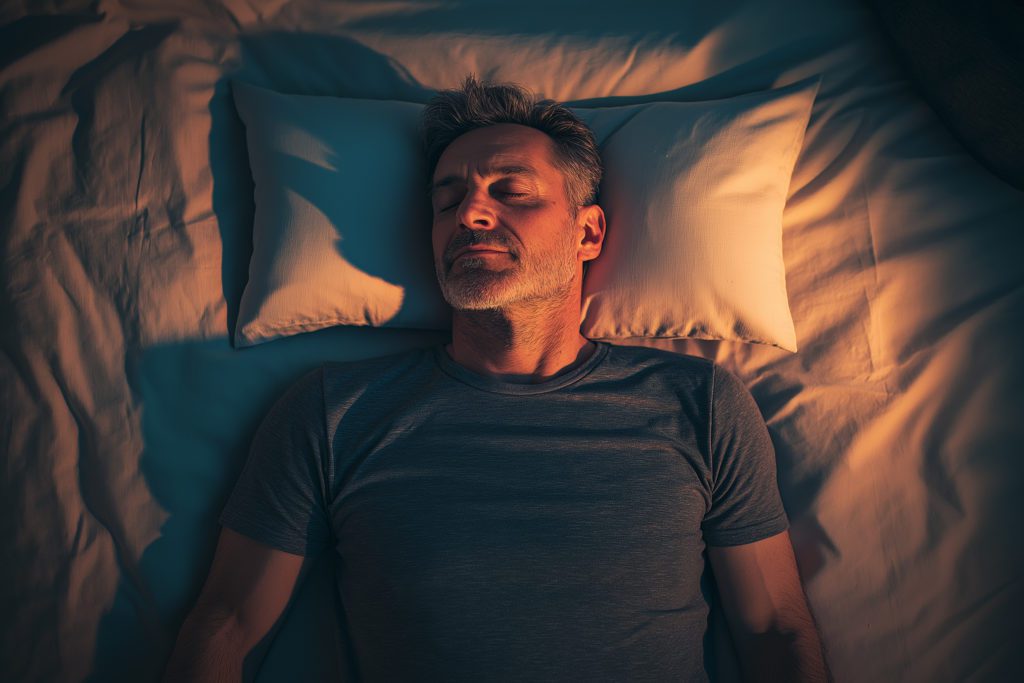
Integrating Yoga into Sleep Hygiene Practices
Yoga is a mind-body practice that increases mindfulness and calms your mind, making yoga a beneficial addition to your sleep hygiene practices.

Yoga is a centuries-old practice grounded in Indian philosophy that still resonates today, and may be your key to unlocking better sleep.
With the ability to relax your body, ease your mind, alleviate tension, and hit your daily exercise goals, yoga offers a way to check all the boxes you need to sleep better at night with its different styles. Whether you need a high-activity class or one centered on stretching, yoga is there to help connect your mind to your body and ensure you’re ready for bed.
How Does Yoga Help You Sleep?
A report from the CDC showed that 59.3% of those who practice yoga report improved sleep, and yogis, in general, perceived higher rates of all self-reported wellness outcomes compared to those who took natural product supplements or tried spinal manipulation with the help of a chiropractor.
With the accessibility of yoga, everyone can benefit from its sleep-improving qualities, whether children or elders.
As for how yoga can help your sleep, here’s how:
Increases Mindfulness
Mindfulness is a practice that focuses on increasing awareness in the moment. While mindfulness can be practiced on its own or through meditation, it’s also a common component of many types of yoga.
Mindfulness offers many benefits for your sleep, with the most notable being its ability to increase your melatonin levels. Melatonin is the sleepiness hormone produced by your body when the sun dips below the horizon. It is what encourages us to fall asleep and stay asleep, so by increasing melatonin levels, yoga does the same.
While easing the process of falling asleep is helpful, what’s more important is that mindfulness has been shown to reduce nighttime sleep disturbances, which leads to more time spent asleep and, more specifically, more time spent in deep sleep. The result of this is higher-quality sleep that leaves you feeling refreshed in the morning.
Practices Deep Breathing
A central element of yoga is its emphasis on breathing awareness and regulation.
Deep breathing is a common relaxation technique, and it works by calming the autonomic nervous system, which leads to a lower heart rate and slowed breathing, two things that help to promote sleep.
In this way, the breathwork during yoga and the principles learned through yoga practice that can be applied at all moments in your life may help you fall asleep more easily.
Acts As a Form of Exercise
Regular exercise is one element of good sleep hygiene, as exercising each day helps your body be better prepared for sleep and sleep better throughout the night.
Many people mistakenly think of yoga as only stretching, and while increasing flexibility is a large part of the practice, many forms of yoga also work on strengthening the muscles and increasing your heart rate, making it an excellent form of exercise that can be perfect for those looking for lower intensity workouts.
Yoga can be a good form of exercise for those who struggle to keep up with other exercises. With its relaxed class style, yoga is often easier to keep up with, and since consistency is important, it can be a great exercise to help improve your sleep hygiene and overall wellness.
Aids Weight Loss
While most people don’t start practicing yoga to lose weight, since yoga—especially its more active styles—is a form of exercise, weight loss can occur.
Losing weight can be a significant help for your sleep, especially if you have obstructive sleep apnea, which has weight loss as a risk factor. By losing weight, you may be able to lessen or, potentially, eliminate your episodes of stopped breathing during the night, allowing you to sleep more throughout the night and see higher quality sleep.
Alleviates Symptoms of Restless Leg Syndrome
Restless leg syndrome (RLS) is a sleep disorder characterized by a compulsion to move the legs and is most often felt when inactive, such as at night while sleeping. As expected, this can make it hard to fall asleep, but yoga may be able to help.
The research is still in the pilot stages, but a study on women with RLS found that their RLS symptoms were significantly alleviated after eight weeks of yoga classes. This evidence shows that yoga may help to combat certain sleep disorders, allowing you to sleep better.
Releases Muscle Tension
Have you ever been unable to fall asleep because you’re in too much pain? Yoga may be able to help.
Yoga releases muscle tension, which relaxes your muscles and reduces any pain you may be holding onto. The result is that, when you go to bed, you won’t be kept awake trying to find a comfortable position because you’ll already be perfectly relaxed.
If you’re in a lot of pain, though, it’s best to check with your doctor before trying yoga. While yoga focuses on gentle stretching, you may injure yourself more. Remember: when stretching, you may feel discomfort, but you should never feel pain. If you’re practicing yoga and feel pain, ease out of the pose and try a variation that is more accessible for your body. If you’re ever unsure of what is within your body’s means, check with your doctor.
Tips to Add Yoga to Your Sleep Hygiene Practices
Yoga offers the ability to improve your sleep—follow these tips to make the most of it:
- Be consistent. While occasional yoga practice will offer benefits to your sleep, you’ll see the greatest effects by practicing yoga regularly, and you can ensure that by making it a part of your nighttime routine.
- Practice calming yoga before bed. Not all types of yoga are created the same—some can raise your heart rate due to the high activity levels, so it’s best to avoid these types. Instead, aim for hatha or nidra yoga; both of these types focus on gentle body postures and breathing techniques, acting as the perfect preparation for bed.
- Practice high-activity yoga during the day. While you’ll want to avoid these types of yoga, such as vinyasa yoga, before bed, they’re a perfect form of exercise to complete during the day.
- Don’t practice in your bed. While some bedtime yoga sequences may seem like a perfect fit for your bed, for good sleep hygiene, you want to leave your bed only for sleeping. So, find somewhere else to practice your yoga.
- Dim the lights. If you’re practicing yoga before bed to calm down and relax your mind and body, try dimming the lights as you practice. This can help prepare your body for sleep and may aid your ability to focus on relaxing through your practice.
When you add yoga to your routine, whether as a daytime exercise, a nighttime relaxation method, or both, your sleep will reap the benefits of this practice formed in stretching, mindfulness, and breathwork. Even if you start small, you may soon find yourself a self-proclaimed yogi who can’t imagine life without this mind-body practice.
FAQ
Are there any types of yoga that are not recommended before sleep?
Yes, certain types of yoga may not be suitable before sleep due to their energizing effects. Power Yoga, Vinyasa, and Ashtanga Yoga involve fast-paced movements, strength-building poses, and increased heart rate, making it harder to wind down. Instead, Restorative Yoga, Yin Yoga, and Yoga Nidra are best for relaxation.
Can yoga help alleviate insomnia?
Yes, yoga calms the nervous system, lowers stress hormones, and increases melatonin levels, helping people fall asleep faster and stay asleep longer. Studies show regular yoga improves sleep efficiency, making it a useful tool for managing chronic insomnia.
Is it necessary to have prior yoga experience to benefit from yoga for sleep?
No, even beginners can benefit from simple, gentle poses and breathing exercises. Practices like Yoga Nidra or Restorative Yoga don’t require flexibility or strength, making them accessible to anyone looking to improve relaxation, reduce stress, and enhance sleep without prior experience.
How does yoga compare to other relaxation techniques for improving sleep?
Yoga is unique because it combines movement, breath control, and mindfulness, addressing both physical and mental stress. While meditation or deep breathing alone can be helpful, yoga’s full-body relaxation effect reduces muscle tension, lowers heart rate, and improves sleep more effectively.
Are there specific breathing techniques in yoga that improve sleep?
Yes, pranayama (yogic breathing) techniques like 4-7-8 breathing, alternate nostril breathing, and diaphragmatic breathing can slow the heart rate, reduce stress, and promote a state of relaxation, making it easier to fall asleep and sleep deeply.
How does yoga influence the body's circadian rhythm?
Yoga helps regulate the body's internal clock by reducing cortisol and promoting relaxation. Consistent practice, especially at the same time each day, can improve circadian rhythm alignment, making it easier to fall asleep and wake up at consistent times naturally.
How does yoga impact sleep disorders like sleep apnea?
Yoga strengthens respiratory muscles and improves oxygen intake, which may help manage mild sleep apnea symptoms. Breathing exercises like pranayama can enhance airflow and lung capacity, but yoga should be used as a complementary practice alongside medical treatments like CPAP therapy.

Written by
Jessica G
Medical writer freelancer who has written hundreds of articles on varying topics. Masters of Engineering degree in Biomedical Engineering.
Download Pillow
Get help
Press & News
Legal
Connect
X (Twitter)
Company
Copyright © Neybox Digital Ltd.



